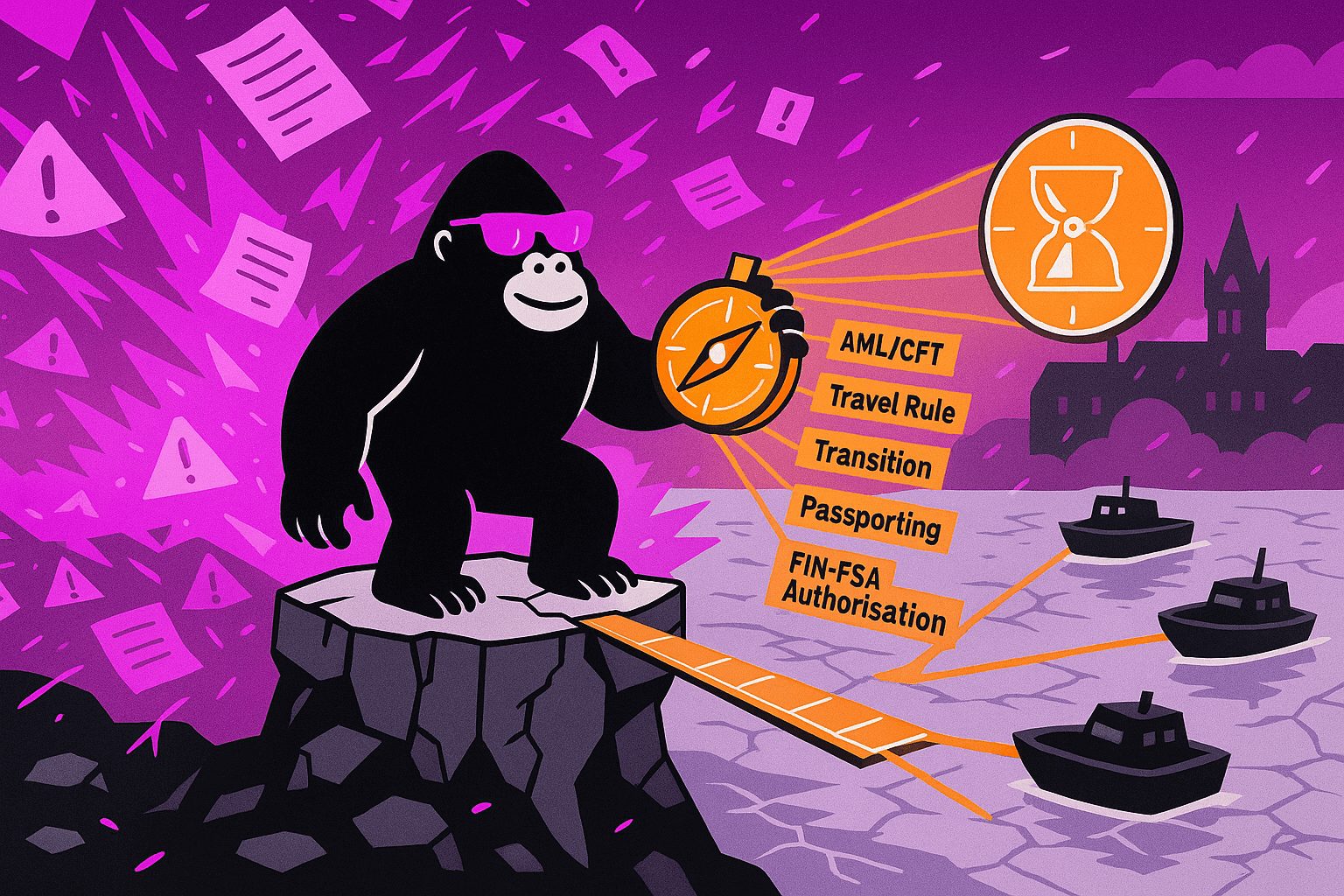From fragmented national rules to a single EU playbook, the Markets in Crypto-Assets Regulation (MiCA) promises clarity—and hefty obligations—for anyone dealing in tokens, wallets, or exchanges. In Finland, MiCA applies directly, with the Financial Supervisory Authority (FIN-FSA) steering enforcement and firms racing to meet twin deadlines in June and December 2024.
In this article, I’ll break down how MiCA works on the ground in Finland, what you need to license your service, how to align your AML/CFT and Travel-Rule systems, and the strategic moves that’ll turn compliance into a growth engine.
Whether you’re a veteran exchange or a lean startup, here’s what you need to know to turn MiCA from a hurdle into a competitive edge.
How FIN-FSA steers MiCA supervision in Finland
You can count on the Finnish Financial Supervisory Authority (FIN-FSA or Finanssivalvonta) to enforce MiCA under Articles 60–62. In April 2025, I flagged their tighter rules on management competence, minimum own funds, data transparency, and information-security obligations—firsts for crypto services here.
They also launched a public register of authorised CASPs and a warning list of unlicensed or suspicious providers. Scammers never sleep—so make sure your warning channels don’t either.
PRO TIP
Subscribe to FIN-FSA’s newsletter or RSS feed. That way, you stay ahead of circulars and adjust your compliance calendar as soon as new guidance drops.
Scoring your MiCA licence: Services, capital & governance
If you “professionally provide one or more crypto-asset services” in Finland, you need MiCA authorisation (Article 62). Here’s a snapshot of what counts and the minimum own-funds you’ll need:
| Service Category | Example Activities | Minimum Own Funds |
| Trading Venues | Centralised exchanges, alternative trading systems | €150 000 |
| Custodial Wallet Providers | Cold-wallet custody | €150 000 |
| Brokers & Order-Execution Services | Matching and execution | €50 000 |
| Transfer & Payment Services (Crypto-Fiat) | Crypto-fiat conversion | €50 000 |
| Portfolio Management & Investment Advice | Discretionary portfolio, advisory | €125 000 |
| Issuance of ARTs and EMTs | Token issuance | ≥ €350 000 (issuers) |
You’ll need to show solid client-asset segregation and, if you custody funds, cold-wallet insurance. Plus, get your governance in order: an org chart, a dedicated compliance officer, conflict-of-interest policies, and “fit-and-proper” attestations for key personnel.
PRO TIP
Team up with your auditors early to validate asset segregation and insurance cover. That pre-check prevents last-minute hiccups in your licence dossier.
Integrating AML/CFT and the Travel Rule without a hitch
From 30 December 2024, all CASPs must obey MiCA’s anti-money-laundering/combating-the-financing-of-terrorism (AML/CFT) rules, including the Travel Rule for reporting crypto transfers. You’ll tie these into Finland’s AML Act 444/2017 and its crypto supplement (Act 572/2019).
I recommend running a gap analysis on your KYC (Know Your Customer) and transaction-monitoring systems against MiCA’s Regulatory and Implementing Technical Standards (RTS/ITS) — that’s your blueprint for data formats and reporting triggers. Test in a sandbox with synthetic data to prove your Travel Rule messages work before you flip the switch.
PRO TIP
Use a controlled test environment to simulate high-volume transfers and edge cases. You’ll catch format errors and false positives long before live customers notice.
Speedy transition: Deadlines you can’t miss
Finland picked one of the shortest transitional periods in Europe. If you were registered under the national Act 402/2024, you can keep operating as long as you file your full MiCA-CASP application by 30 October 2024—and you’ll stay live until 30 June 2025 or until FIN-FSA decides. If you weren’t registered, you must secure your MiCA licence by 30 December 2024 or risk a service shutdown.
| Entity Type | Application Deadline | End of Transitional Operations |
| Pre-existing Registered Providers | 30 October 2024 | 30 June 2025 |
| New or Unregistered Providers | 30 December 2024 | Licence required immediately |
PRO TIP
Set up a dedicated transition team now. Assign roles for document collection, governance updates, and IT checks. The earlier you streamline, the less stress you’ll face as deadlines loom.
Tactical moves for crypto firms in Finland
Once you’ve locked in authorisation, here’s how to level up:
- Engage Early with FIN-FSA: Join “MiCA infopäivät” (info days) and book bilateral sessions to nail down dossier specs.
- Leverage EU Passporting: After Finnish authorisation, notify FIN-FSA to list your cross-border activities and expand EU-wide without extra licences—a real flex for growth.
- Tailor Disclosures: Draft MiCA-compliant white papers for ART/EMT issuers in clear, nondisruptive language, and respect Finnish-language marketing rules.
- Focus on Consumer Protection: Keep an eye on scam patterns. Maintain a rapid-response channel so your support team can act fast on user complaints.
- Monitor ESMA Standards: Track the European Securities and Markets Authority’s draft and final RTS/ITS to anticipate new obligations long before they hit your inbox.
PRO TIP
Build a rolling compliance calendar tied to ESMA’s publication schedule. Automate alerts for upcoming consultations so you can influence standards and budget for any changes.
Your roadmap to MiCA success
Here’s a clear, actionable plan to go from “prepped” to “fully compliant”:
| Step | Action Items |
| Conduct a Gap Analysis | Map your current setup against MiCA and FIN-FSA guidelines for AML/CFT, governance, and ICT resilience. |
| Assemble the Dossier | Draft your governance manuals, ICT system schematics, AML/KYC policies, financial forecasts, white papers. |
| Engage with FIN-FSA | Schedule pre-application meetings, send draft questions, and confirm fee structures. |
| Train and Communicate | Run workshops so your teams grasp MiCA duties, reporting lines, and breach-notification protocols. |
| Monitor Regulatory Updates | Subscribe to ESMA and FIN-FSA feeds to capture any tweaks to technical standards or guidelines. |
PRO TIP
Form cross-functional working groups with legal, IT, finance, and compliance reps. Use collaborative tools to track tasks and deadlines—nothing worse than a loose thread in your MiCA project.
Streamline MiCA compliance with CyberUpgrade
Meeting MiCA’s rigorous requirements—from whitepaper filings to ongoing governance and transparency—often means endless manual tracking and audit prep. CyberUpgrade automates your MiCA workflows with prebuilt templates and real-time Slack or Teams prompts, keeping policies, risk assessments, and evidence audit-ready in one central hub.
Beyond MiCA, CyberUpgrade also supports DORA, ISO 27001, and NIS 2 frameworks, letting you “map once, prove many” across multiple regulations. Automated data extraction, vulnerability scans, and KPI dashboards feed each regulator’s portal seamlessly, reducing manual work by up to 80 %.
With fractional CISO services guiding your continuous monitoring and customizable compliance workflows, you’ll secure faster approvals, avoid fines, and adapt as MiCA and related frameworks evolve—turning compliance from a hurdle into a strategic advantage.
Ready to make MiCA your competitive edge?
By embracing MiCA’s unified regime, partnering closely with FIN-FSA, and embedding rigorous compliance into your operations, you’ll not only lock in legal certainty but also unlock EU-wide passporting advantages.
It takes discipline and clear planning, but the payoff—a resilient, scalable crypto service in 27 Member States—is more than worth it. If you’re curious how these steps apply to your platform or want to deep-dive on passporting tactics, drop CyberUpgrade a line—we’ve got you covered.









